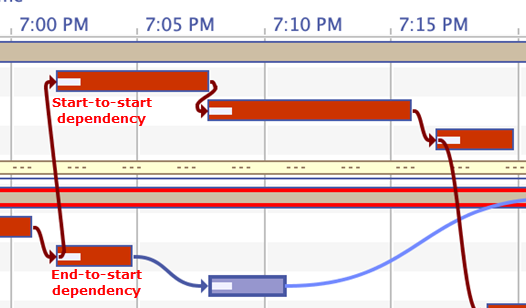Job Dependencies in Universal Schedulers
In addition to end-to-start dependencies in jobstreams, universal schedulers also support start-to-start job dependencies. An end-to-start dependency means that a job starts when its predecessor ends. A start-to-start job dependency means that a job starts when its predecessor starts.
To understand how Automic Automation Intelligence calculates the latency in either type of dependency, you must be acquainted with the following concepts:
-
Finish
Time when a dependency condition is met. For end-to-start dependencies this is when the predecessor job ends. For start-to-start dependencies this is when the predecessor job starts.
-
Finish to start latency
Lapse of time between Finish and the successor start
-
For end-to-start dependencies, the Finish to start latency is calculated as follows:
Successor start time - Predecessor end time
-
For start-to-start dependencies the Finish to start latency is calculated as follows:
Successor start time - Predecessor start time
Note:(CA Workload Automation ESP only) ESP jobs always have a parent application. For calculating their Finish to start latency, the minimum latency is used. One of the following calculation methods is used:
-
min(successor start time - parent start time)
-
min(successor start time - Finish)
-
Graphic Representation
You can easily recognize start-to-start and end-to-start dependencies in the Gantt chart.
The arrow for a start-to-start dependency goes from the beginning of the successor job to the beginning of the predecessor job. The arrow for an end-to-start dependency goes from the end of the successor job to the beginning of the predecessor job.

Predictions and Forecast Calculations
For both types of dependencies, the average Finish to start latency is always considered in forecast calculations.